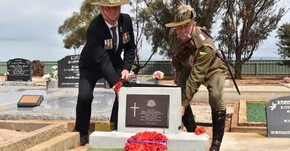
S4520
ROBERTS, Henry Wood
| Service Number: | 3672 |
|---|---|
| Enlisted: | 1 February 1916 |
| Last Rank: | Sapper |
| Last Unit: | 1st Tunnelling Company (inc. 4th Tunnelling Company) |
| Born: | Mallalla, South Australia, 16 January 1895 |
| Home Town: | Northfield (Yatala), Port Adelaide Enfield, South Australia |
| Schooling: | Not yet discovered |
| Occupation: | Contractor/Labourer |
| Died: | Port Wakefield, South Australia , 16 May 1977, aged 82 years, cause of death not yet discovered |
| Cemetery: |
Port Wakefield Cemetery, S.A. C of E plot 84 |
| Memorials: | Owen District of Dalkey Roll of Honor, Port Wakefield Memorial Arch |
World War 1 Service
| 1 Feb 1916: | Enlisted AIF WW1, 3672, 1st Tunnelling Company (inc. 4th Tunnelling Company) | |
|---|---|---|
| 22 May 1916: | Involvement Sapper, 3672, No 4th Tunnelling Company - Headquarters No 1, --- :embarkation_roll: roll_number: '6' embarkation_place: Sydney embarkation_ship: HMAT Warilda embarkation_ship_number: A69 public_note: '' | |
| 22 May 1916: | Involvement Sapper, 3672, 1st Tunnelling Company (inc. 4th Tunnelling Company), --- :embarkation_roll: roll_number: '6' embarkation_place: Sydney embarkation_ship: HMAT Warilda embarkation_ship_number: A69 public_note: '' | |
| 22 May 1916: | Embarked Sapper, 3672, 1st Tunnelling Company (inc. 4th Tunnelling Company), HMAT Warilda, Sydney | |
| 22 May 1916: | Embarked Sapper, 3672, No 4th Tunnelling Company - Headquarters No 1, HMAT Warilda, Sydney | |
| 11 Nov 1918: | Involvement Sapper, 3672 | |
| 25 Jul 1919: | Discharged AIF WW1, 3672, 1st Tunnelling Company (inc. 4th Tunnelling Company) |
Help us honour Henry Wood Roberts's service by contributing information, stories, and images so that they can be preserved for future generations.
Add my storyBiography contributed by Paul Lemar
Henry Wood ROBERTS was born at Mallala on 16.01.1895 to Joseph Henry (1858-1934) and Grace Burlington ROBERTS (nee WOOD) (1866-1953).
Henry Wood ROBERTS joined the AIF at the age of 21 on 01.02.1916 and was allocated service number 3672. He was made a sapper with the 1st Australian Tunnelling Company. He departed Australia on 22.05.1916 for the Western Front.
He had a number of hospital admissions for illness during his service.
He was discharged from the AIF 25.07.1919. He is commemorated on the Port Wakefield Arch of Honour and the District of Dalkey Honour Board.
The 1st Australian Tunnelling Company was one of the tunnelling companies of the Royal Australian Engineers during World War I. The tunnelling units were occupied in offensive and defensive mining involving the placing and maintaining of mines under enemy lines, as well as other underground work such as the construction of deep dugouts for troop accommodation, the digging of subways, saps (narrow trenches dug to approach enemy trenches), cable trenches, and underground chambers for signals and medical services.
On 7 November 1916, the 1st Australian Tunnelling Company took over the mines at Hill 60 from the 1st and 3rd Canadian tunnelling companies. The mines placed under the German lines by the 3rd Canadian Tunnelling Company had already been charged with explosives by the time the Australians arrived in the area. The first mine (Hill 60) contained 53,000 pounds (24,000 kg) of ammonal explosive and the second (The Caterpillar) contained 70,000 pounds (32,000 kg). The galleries formed part of the series of mines that was dug by the British 171st, 175th, 250th, 1st Canadian, 3rd Canadian and 1st Australian Tunnelling companies as part of the prelude to the Battle of Messines (7–14 June 1917), while the British 183rd, 2nd Canadian and 2nd Australian Tunnelling companies built deep dugouts (underground shelters) in the Second Army area.
As part of the preparations for the Battle of Messines, the 1st Australian Tunnelling Company was tasked with ensuring that the tunnels and explosives beneath Hill 60 and The Caterpillar remained intact and undiscovered by the Germans over the next seven months. Drainage and ventilation shafts had to be dug in the unfamiliar blue clay, and there was a constant danger of collapse, particularly in the part of the gallery leading to The Caterpillar, which passed under the railway line. At the same time, listening posts had to be maintained to detect enemy action. These posts were only a few metres underground and therefore susceptible to collapse during bombardments. The German mining units were constantly trying to find British tunnels and numerous counter tunnels had to be dug towards the German excavations so that they could be mined with small charges and destroyed. In April 1917, German infantry conducted a raid into the British lines in an attempt to find the entrances to the British mine galleries but failed to do so. On 25 April 1917, a detonator exploded in the Australian underground HQ, killing ten men. The Official Australian History states that at Hill 60, "underground warfare reached a tension which was not surpassed anywhere else on the British front". It is estimated that altogether approximately thirty Australian tunnellers were killed at Hill 60. The mines at Messines were eventually detonated on 7 June 1917, creating 19 large craters.
The 1st Tunnelling Corp saw service at ony - Ypres - Hill 60 - St Eloi - Hooge Hame - Dinant - Amiens - Le Biset Louvain -Corbie - Namur - Louvain Peronne - Bellicourt - St Quentin - Menin Road-Polygon Wood Ploegsteert Wood - Villers-Bretonneux










